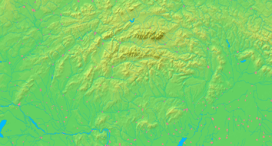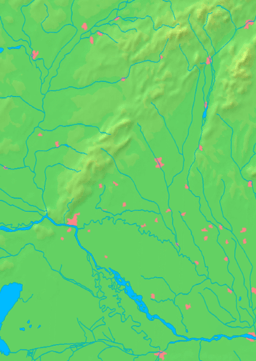Šaštín-Stráže
| Šaštín-Stráže | |
| Town | |
 A basilica in Šaštín | |
| Country | Slovakia |
|---|---|
| Region | Trnava |
| District | Senica |
| Tourism region | Záhorie |
| River | Myjava River |
| Elevation | 170 m (558 ft) |
| Coordinates | SK 48°38′30″N 17°09′05″E / 48.64167°N 17.15139°ECoordinates: SK 48°38′30″N 17°09′05″E / 48.64167°N 17.15139°E |
| Area | 41.951 km2 (16.197 sq mi) |
| Population | 5,056 (31 December 2005) |
| Density | 121/km2 (313/sq mi) |
| First mentioned | 1218 |
| Mayor | Ján Hladký |
| Timezone | CET (UTC+1) |
| - summer (DST) | CEST (UTC+2) |
| Postal code | 908 41 |
| Area code | +421-34 |
| Car plate | SE |
  Location of Šaštín-Stráže in Slovakia | |
  Location of Šaštín-Stráže in the Trnava Region | |
| Wikimedia Commons: Šaštín-Stráže | |
| Statistics: MOŠ/MIS | |
| Website: http://www.msu-sastinstraze.sk | |
Šaštín-Stráže (German: Schoßberg-Strascha, Hungarian: Sasvár-Morvaőr, Turkish: Şaşvar) is a town in the Senica District, Trnava Region in western Slovakia. Originally two separate villages, now it is one of the youngest towns in Slovakia, having received town privileges on 1 September 2001.
Etymology
The Hungarian name of Šaštín (Sasvár) consists of two parts: sás (sedge) and vár (castle). The Slovak name is similiar: šáš (šašina, šáchor, present also in other Slavic languages – a sedge)[1] and týn (initially a fence, later also a small medieval fort). The name Stráže (guards) refers to a historic settlement of border guards.[2]
Geography
The town lies in the Záhorie lowlands, around 18 km (11 mi) from Senica and 65 km (40 mi) from Bratislava. The Myjava River flows through the town, dividing the town's two parts.
History
The first written mention about Šaštín-Stráže was in 1218. In the Middle Ages this settlement was part of the Székely border defense of the Hungarian Kingdom. Therefore, the village has historical connections with the Székely ethnic group. The town went under the direct control of Ottoman Empire in 1663, following the Austro-Turkish War (1663-1664) and was the center of a sanjak in Uyvar Eyalet. It was referred as Şaşvar under Turkish control by the Ottoman Turks. Although the town's two parts, Šaštín and Stráže nad Myjavou were for long two separate villages, their history is closely connected to each other. The villages merged in 1961 under name Šaštínske Stráže, changed in 1971 to the current name.
Demographics
According to the 2001 census, the town had 5,005 inhabitants. 95.44% of inhabitants were Slovaks, 2.06% Roma and 1.50% Czechs.[3] The religious makeup was 88.45% Roman Catholics, 7.31% people with no religious affiliation, and 1.34% Lutherans.[3]
Importance
Šaštín-Stráže is one of the most important Marian shrines in Slovakia. Several pilgrimages are held there annually, especially on Pentecost and Our Lady of Sorrows Day (15 September).[4]
References
- ↑ Ondruš, Štefan (1996). "Slovo šaš nepochádza z maďarčiny" [The word šaš does not come from the Hungarian language] (PDF). Slovenská reč (in Slovak) (2).
- ↑ Závodný, Andrej (2007). "O názvoch riek a potokov na Záhorí" [About river and creek names in Záhorie]. Záhorie (in Slovak) (1).
- 1 2 "Municipal Statistics". Statistical Office of the Slovak republic. Archived from the original on 17 December 2007. Retrieved 25 December 2007.
- ↑ "Národná bazilika Panny Márie" [Roman Catholic Church in Slovakia]. Retrieved 8 September 2008.
External links
- Official website (Slovak)
- Unofficial website (Slovak)